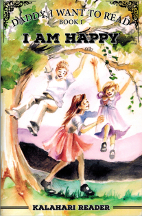The Kalahari Readers are intended to be used as a “learn to read” program for children about five or six years old. The series was written by Dr. R. Bryan while his family was living as Christian missionaries in a tent in the Kalahari Desert. Consequently, the readers have an international flavor that is unusual in beginning readers. Readers are also available in three different versions for the U.S., Canada, and for Britain and other English speaking countries with appropriate adaptations of spelling and pronunciation for each.
The set consists of five Daddy, I Want to Read readers and an Instruction Manual. Readers are each 52 pages in length. Sturdy, laminated covers are printed with lovely, full-color illustrations. Inside pages are primarily black-and-white although sight words are printed in blue. Line-drawn illustrations by the cover illustrator also incorporate occasional drawings of the Bryan family as part of the lessons. Reading lesson material sometimes refers to the family, and the illustrations help acquaint young readers with mom, dad, Victoria, Roy, and Charity.
The instruction manual is relatively brief, leaving it to parents to work through lessons without detailed assistance. Consequently, I would recommend these readers to parents who are fairly confident of their ability to teach reading.
The approach is a combination of phonics and sight words. Some words such as yellow are first introduced as sight words (called special words in this series) then later taught phonetically after children have learned more foundational skills. The sequence of skills differs from many other programs. For example, consonant digraphs such as st and nd are introduced early in the first reader so children can sound out words like ant and sand. Simultaneously, they learn the “special” words the and I so that they can quickly begin to read sentences.
On page 14, the first reader makes reference to the optional book, Tom at the Beach. Tom at the Beach is included in the center of the Instruction Manual and should be used with children who need or want more reading practice at this early stage.
While the first reader teaches short-vowel words, the progression after that diverges from the standard approach of teaching long-vowel words then other phonograms. For example, the second reader teaches ir, er, and ur words plus ing suffixes before teaching long-e words such as see and tea. This isn’t a problem, but it means the readers are unlikely to align with another reading program as a supplement.
Special words that have been introduced as sight words are in blue throughout most of the first four readers to alert students that these are words they need to memorize rather than sound out. Once in a while, there is a short story all in black typeface for students to practice without the assistance of “highlighted” sight words.
Continual review is built into the lessons, so children are reviewing specific words as they also encounter previously-learned words in sentences. A couple of pages in the third and fifth readers should be used as activity pages with children writing or coloring on those pages. You are given permission to copy those pages as needed for your children rather than have them write in the books.
The content is definitely Christian with references to God, Jesus, Church, and faith. For example, the fourth reader includes the sentences, “Jesus loves me. The Bible tells me so.” The fourth reader has a story about going to church on Sunday that gives children insight into church attendance in Africa: “Our church in Africa is a little different. We sing and we pray inside the church. Then the children go outside for Sunday school. We sit on a mat under a big tree. The Sunday school teacher tells us about Jesus and the Bible.”
International references and explanations show up from time to time as in the paragraph above. In another instance, one reader explains that a “rubbish bin” is called a “trash can” in the United States. The fifth reader talks about Guy Fawkes Day which is celebrated in England.
Readers often include sentences about rural life such as in the third reader where it says, “The nanny goat nursed her kid.” Family life is presented very positively throughout the series as well. The last few readers also include some nursery rhymes.
By the end of the fifth reader, children are reading words such as plough, drought, neighbor, and education. The pace of the program might be a bit fast for some children, so slow down if need be, perhaps providing practice with other reading material if it is helpful. While the sequence of instruction is a little unusual, it is logical, building skills one upon another.
I found the Kalahari Readers delightfully different. The unusual content is likely to be very interesting to children. Rather than typical reader content, who wouldn’t rather read, “Would you swim in the river if you could? Should you swim in the river if you could” Would a crocodile eat you? Perhaps you should not swim in the river” (Book 5, page 1).
While you can order books individually, buying the inexpensive set makes the most sense.








